
April’s ChildrensLit Now newsletter looks at the outside and the inside- of both animals and humans. Our Notable Reviews this month include new books that ask if people only see our outside selves. This month’s Book Award You Need to Know looks at science.
With spring, there is new growth. In reading, there can be new growth as well. Books about people different than ourselves and books about those similar to us help us to grow both inside and out. Our perspective can shift. What we believe can be proven or disproven. Above all, we learn. Happy Reading!
Shelley Oakley
Director, Children's Literature
Subscribe to ChildrensLit Now Newsletter
In case, if you have missed our previous issue.

Rick, Alex Gino’s stand-alone follow-up to their 2015 award winner, George (now commonly referred to as Melissa), follows the titular middle-schooler as he works to understand his blossoming sexuality. Or, rather, his lack thereof. Rick identifies as either asexual or aromantic. This funny story centers on the conversation about agency, friendship, and self-identity as Rick enters sixth grade. After realizing that he never gets the feelings everyone has started talking about when he sees girls or boys, Rick begins to question what that means. He also begins to question his friendship with Jeff, whose antics have turned from teasing his peers to fights, vandalism, and outright homophobia. To process his newly discovered lack-of-feelings, Rick goes to the Rainbow Spectrum club, a school-based group. There, he is introduced not only to a set of vocabulary for talking about his identity but also to people very much unlike Jeff. The other attendees at the club are kind and supportive of Rick and each other--exactly the type of people Rick wants as friends. Gino’s middle-grade novel does sometimes near didacticism, but it does so unapologetically as it works to provide a textual equivalent to the Rainbow Spectrum club, which many young readers may not have access to at their own school. This is a "must-have" for socially-conscious collections seeking to provide a greater breadth of content that is LGBTQ+ supportive and affirming.
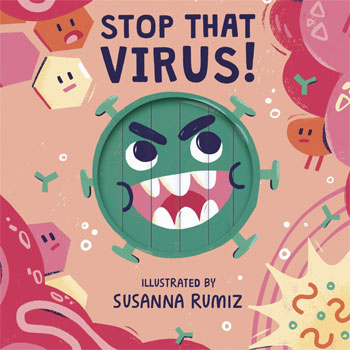
The body’s immune defenses thwart an invading virus in this board book, featuring moveable pieces. With a sly expression, that villainous virus attempts to sneak into a person’s body; fortunately, the cell it invades is well-prepared. The storyline that follows is both enjoyable and easy for a young child to understand. The immune response is depicted in an approachable and humorous way, using concrete items like warning signs to show how the body is prepared to fight against intruders. Advanced vocabulary, such as “enzymes” or “antibodies,” is introduced. The cartoon-like illustrations are vibrant and fun, with enzymes brandishing megaphones and antibodies showing up wielding arrows. The moveable flaps are a major highlight, as elements such as the virus’ expression shift with the turn of the page. Overall, this engaging book provides a very basic introduction to the body’s natural defenses and one that could help to ease any fears or anxieties that children might have about illnesses.
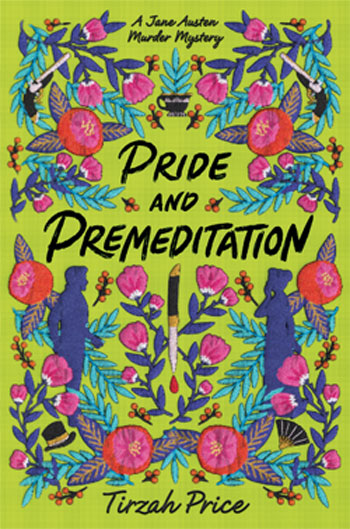
In this clever riff on a beloved classic, the Bennet family lives in Cheapside, being kept from social advancement by an appropriate set of hurdles. Rather than country estates, the contested terrain here lies in Mr. Bennet’s law firm, slyly titled Longbourn and Sons, despite there being nary a son in the family. The relationships faithfully mirror those in Austen’s Pride and Prejudice, even while the novel turns a quizzical lens on the story. Lizzie’s best friend Charlotte (biracial, her mother being from the West Indies) is Mr. Bennet’s employee, while the irksome Mr. Collins is set to inherit the practice. Lizzie longs to represent in court a client accused of a scandalous murder. Alas, it’s beyond the pale for a young woman to do such a thing, so instead, she throws herself into solving the case. Her surreptitious investigations lead her to places as unsavory as London’s docks and the innards of Newgate Prison. The familiar cast of characters is nicely updated, with all given new purpose well-suited to the murder mystery genre. This makes it possible to upend societal norms, making the subtext of Austen’s drawing-room politics more visible. Wickam meets his just desserts, and true fans will be happy to know that the PI role doesn’t hurt the romantic tension between Lizzie and Darcy. An author’s note clarifies and justifies liberties taken with the social context of Regency England. A love letter to Austen and Agatha Christie, with a dash of feminism.
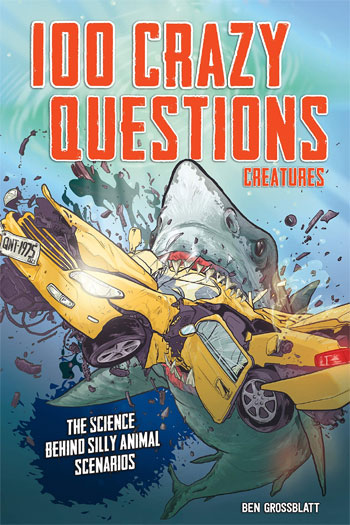
Most kids love animals and feel curious about all creatures. This book of questions will give readers the answers they are looking for while offering a little humor on the side. Using one- and two-page spreads, readers will explore dozens of questions, each with the answer below. Most of the questions are expressed in humorous ways, while the answers are still clear and concise. In addition, each subject includes “features” in a table format with facts like the animal's size, where it can be found, and it's scientific name. More than 100 animals are profiled in this small book of animal facts, and they are organized in categories of amphibians, birds, fish, invertebrates, mammals, and reptiles. Animals as familiar as a domestic cat and as strange as a tamarin monkey can be found in this graphic title. Beautiful photographs throughout show the animals in all their beauty, and these are accompanied by some of the silliest questions you have ever contemplated. Middle school readers will enjoy this compact resource of quick information about animals of the world. This title is recommended for the middle school science curriculum.
Uma Krishnaswami

Uma Krishnaswami is a woman of many talents- writing, teaching, knitting, and more. But at Children's Literature, we know Uma additionally as one of our best longtime book reviewers. Uma's gift for book analysis helps readers, parents, educators, and librarians understand a book in a way that defies any average book review. She dives deep into the plot, characterizations, and impact of a book. Her eloquent way of describing the significance of a title and helpful critique leaves the reader better and also the author. It is a voice like hers that helps us understand the place of children's literature in society and, more importantly, in a child's growth. It's hard to narrow an interview to just a few short questions when interviewing someone as prolific as Uma. Her talent in so many areas is why we need to ask her so much. But alas, we asked a few varied questions on the hearts and minds of children's book lovers in 2021.
First, we want to congratulate you on your 2021 Award nomination for the Astrid Lindgren Memorial Award, the global award given to a person or organization for outstanding contribution to children's and young adult literature. Your works have won many awards and honors and still appear on numerous best book lists, but what was the feeling of being considered for this particular award?
Uma: Thank you for the congratulations. It turns out that I’ve been nominated twice in successive years, and no one’s more surprised than I am! The first time was in 2020, when the nominating group contacted me to ask for things like my address and phone number, and so on. To be honest, at first, I thought it was a joke, but my agent assured me that wasn’t the case! Well, 2020 came and went after sweeping us all up into the Covid-19 pandemic quake. And I thought, well, it was very nice to be nominated, and it’ll never happen again. Then in the spring of 2021, I started getting congratulatory notes from people who were obviously keeping a sharper eye on such things than I do, which was when I realized I’d been nominated again. It’s a gratifying vote of confidence in my work, and I can’t deny that I’m very pleased. It perks me up on days when my inner writer gets into a slump, which happens from time to time.
Your books have been translated into multiple languages so that they are available to children around the world. How important is it for children to read books published in other countries?
Uma: I think it’s critical. Books that are published in a lot of different places offer many different approaches to storytelling, in a variety of styles, with varying viewpoints, settings, characters, and themes. If children understand and appreciate fiction and nonfiction from different parts of the world, they’ll come closer to understanding and appreciating places and people different from themselves. I’d argue that far from being a luxury, it’s essential for future generations around the world to understand and speak to one another. The life of our planet depends on it. The corollary to that is that we also need books that show children of every country their own reflections. That way, to use Rudine Sims Bishop’s wonderful metaphor, books that are windows for some will be mirrors for others. Which is why I’m so thrilled every year to see awards for translated books like the Batchelder Award and the GLLI YA Book Prize.
What significant changes have you seen in children's and YA literature since you published your first book in 1994?
Uma: I don’t know if I’m qualified to speak to that question on its largest scale because everything I know is just one small slice of that reality. So, I’ll answer it on a smaller scale, as a writer and reader. Having stood my ground through plenty of early rejections and having had editors and agents question whether there’d be any interest in the kinds of stories I was trying to write early on, the biggest change I see is that the field may finally be opening up to a diversity of voices. I say this cautiously because it hasn’t happened without a struggle, and I’m very aware that trends come and go in cycles. Still, it does seem to me that we’ve made some shifts here due to the CCBC’s documentation of diversity statistics, the work of publishers like Lee and Low, and groups like We Need Diverse Books. I think some of the shift is also to the social and political turmoil of the past few years that really has led to a point, in the United States at least, of rethinking and reevaluating history and its darker legacies. At any rate, we see the emergence of publishing houses like Levine Querido and new imprints like Heartdrum and Kokila. This is true to some degree in Canada as well, although the market here is smaller, but some of those historical through-lines are certainly shared. In all, it seems to me that the kind of writing I’ve found personally interesting, the stories I’ve been drawn to over the years, as well as the kind of writing I like to read, are being centered in the conversation in a way they’ve never been before.
What trajectory would you like to see children's literature take in 2021 and moving forward? What trajectory would you like to see YA literature take?
Uma:I’ve always believed in the power of books to shape the minds of young readers. Some writer friends have told me how much the pandemic and so many other events in the real world have shaken their ability to write or their faith in the craft of writing itself. So, I don’t know that I have a straightforward answer to that question at all. What would I like to see? I know what I think we need. We need books that make bold, imaginative leaps. We need ways to find joy and community while refusing to be blinded by nostalgia for a past that never really existed. Two books by writers I’m proud to count as friends and colleagues contain great lavish helpings of all those elements: A Sitting in St. James by Rita Williams-Garcia, and Sisters of the Neversea by Cynthia Leitich Smith. The first is a YA novel, an epic multi-generational story of life, death, crime, love, survival set against the astonishingly vivid background of a declining antebellum Louisiana plantation. In the other, a middle grade novel, Lily and Wendy reclaim the Peter Pan universe, speaking back to the canon with humor and grace. Back in 2019, I wrote an article in The Horn Book back calling for diverse books to be more than windows and mirrors—I argued they can also work as prisms that refract the light of their characters and themes and cast them back upon the real worlds of readers. Both these books do that in very different ways. So, I’d argue that windows and mirrors are necessary but as the world gets increasingly complicated, representation is not enough. I’ll be looking in 2021 for more books that act like prisms.
With all of the books you reviewed in 2020 and 2021 so far, which has been your favorite and one you hope will make award and best book lists this year?
Uma:I never try to second-guess awards, and I can never just pick one book, so I’ll tell you about several that I found memorable:
We’re always waiting on a new book from you. What are you working on now? Any books to be released later this year?

Uma: I try to juggle a picture book and a longer work at all times. At the moment I’m in transition so I seem to have a couple of each on my hands, while I figure out where I should settle my attention for the next stretch.
I’m pleased to say I have two books slated to be released later this year: Threads of Peace: How Mohandas Gandhi and Martin Luther King Jr. Changed the World (middle grade nonfiction from Caitlyn Dlouhy Books/Atheneum) will be out in August. Two at the Top: A Shared Dream of Everest (a picture book illustrated by Christopher Corr, from Groundwood Books) follows in October.
You can find out more about Uma on her website https://umakrishnaswami.org/.
Giverny Book Award
The Giverny Award is an annual children's science picture book award established in 1998 by Dr. Jim Wandersee and Dr. Elisabeth E. Schussler who was at that time affiliated with the 15º Laboratory at Louisiana State University. The 15º Laboratory performs research on visual cognition in biology, visual approaches to learning biology, and the graphic representation of biological knowledge. The winning book must be a children's science picture book written in the English language and published within five years of the award date. Books chosen are typically picture books geared towards children between ages 4-8. The winning book must teach its young reader at least one important scientific principle well or encourage the reader toward specific science-related attitudes, pursuits, or inquiries. Sponsored by: 15 Degree Laboratory.
For the complete list of winners since 1998, visit http://www.15degreelab.com/givernyawardwinnerlist.html.
2020 Winner
They All Saw A Cat by Brendan Wenzel
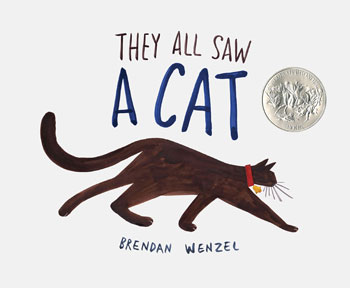
In simple, rhythmic prose and stylized pictures, a cat walks through the world, and all the other creatures see and acknowledge the cat. When you see a cat, what do you see? A celebration of observation, curiosity, and imagination.
2019 Winner
Counting on Katherine: How Katherine Johnson Saved Apollo 13 by Helaine Becker and illustrated by Dow Phumiruk
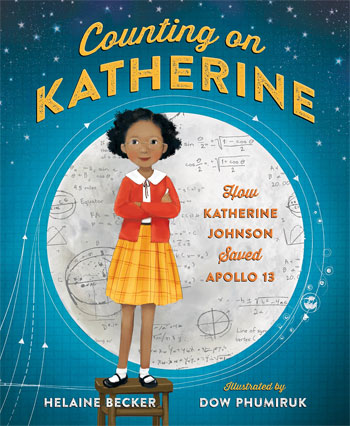
As a child, Katherine Johnson loved to count. She counted the steps on the road, the number of dishes and spoons she washed in the kitchen sink, everything! Boundless, curious, and excited by calculations, young Katherine longed to know as much as she could about math, about the universe. From Katherine's early beginnings as a gifted student to her heroic accomplishments as a prominent mathematician at NASA, Counting on Katherine is the story of a groundbreaking American woman who not only calculated the course of moon landings but, in turn, saved lives and made enormous contributions to history.
2018 Winner
Bat Count: A Citizen Science Story by Anna Forrester and illustrated by Susan Detwiler
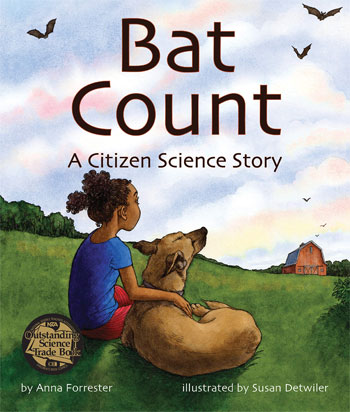
Jojo is prepping for an exciting night; it’s time for the bat count! Bats have always been a welcome presence during the summers in the family barn. But over the years, the numbers have dwindled as many bats in the area caught white-nose syndrome. Jojo and her family count the bats and send the numbers to scientists who study bats to see if the bat population can recover. On a summer evening, the family quietly makes their way to the lawn to watch the sky and count the visitors to their farm.
2017 Winner
The Tree Lady by H. Joseph Hopkins and illustrated by Jill McElmurry
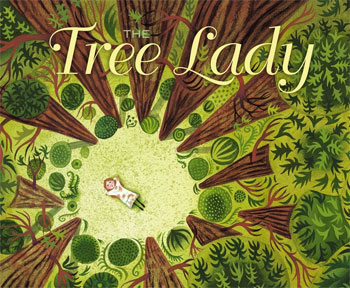
Katherine Olivia Sessions never thought she’d live in a place without trees. After all, Kate grew up among the towering pines and redwoods of Northern California. But after becoming the first woman to graduate from the University of California with a degree in science, she took a job as a teacher far south in the dry desert town of San Diego. Where there were almost no trees. Kate decided that San Diego needed trees more than anything else. So this trailblazing young woman singlehandedly started a massive movement that transformed the town into the green, garden-filled oasis it is today. Now, more than 100 years after Kate first arrived in San Diego, her gorgeous gardens and parks can be found all over the city.
★Are you an indie author or a traditional published author who has recently self-published? If so, check out the Children’s Literature Indie Author Promotions Service. This service includes your book’s entry in Children’s Literature Comprehensive Database (CLCD), a book review, participation in the new Children’s Literature Booking Service (coming August 2021), and more. For more information, visit https://www.childrenslit.com/indie-authors.